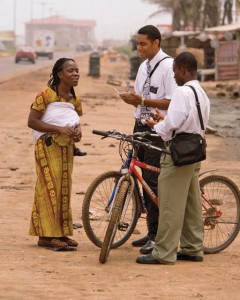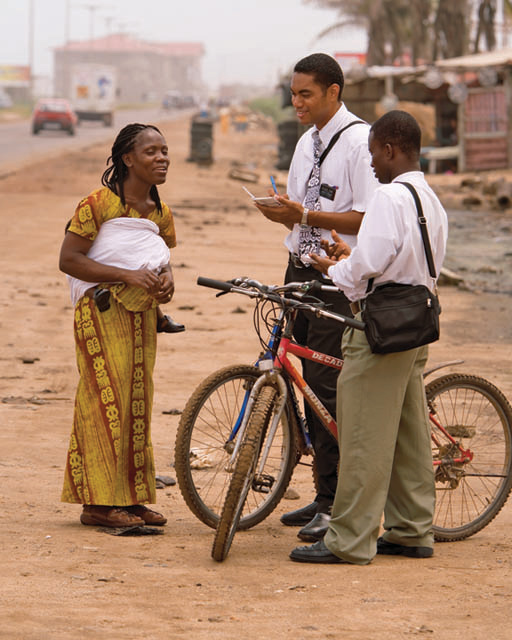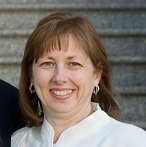In 1974, Spencer W. Kimball, the Mormon Prophet, in his first address as President of the Mormon Church, announced that he had received a revelation that every worthy, young man should serve as a Mormon missionary. In the years up to that time, around 8,000 new Mormon missionaries were sent out each year. By 1975, the number had risen to 15,000 in response to the prophet’s call, and the number has increased nearly every year since then. Behind these numbers are thousands of stories of faith and sacrifice, full of miracles and hard work by ordinary people devoted to God and Jesus Christ. Under President Spencer W. Kimball, the Mormon Church saw new areas open up to missionary work, and the beginnings of the remarkable growth of the 1980s and 1990s that would propel the Mormon Church into international status. In 1974, when President Kimball made that remark, there were just shy of 3,000,000 Mormons worldwide; that number would triple by the year 2000.
 President Kimball, who struggled with severe health problems during his life, urged Mormons and Mormon missionaries to rise to the challenge to take the message of the Gospel of Jesus Christ to all people. To do this, a new program of translation was undertaken to place the Book of Mormon and other Mormon books into the hands of all people. From 1974, when President Kimball became Prophet and President of the Mormon Church, to 1990, when translation work began to slow down again, the Book of Mormon was translated into 57 new languages. In 1981 alone, the Book of Mormon was published for the first time in Russian, Catalan, Icelandic, Niuean, Bolivian Quechua, Kuna, Romanian, and Polish. In the 1980s, as part of this new growth, President Ezra Taft Benson, who became Prophet and President to the Mormon Church in 1985, issued a call to flood the earth with the Book of Mormon. Members were encouraged to carry copies of the Book of Mormon with them and to increase their efforts to share its message about Jesus Christ with everyone they met. By the late 1980s, Mormon missionaries were baptizing more than 300,000 people a year, and the number of fulltime missionaries was close to 50,000.
President Kimball, who struggled with severe health problems during his life, urged Mormons and Mormon missionaries to rise to the challenge to take the message of the Gospel of Jesus Christ to all people. To do this, a new program of translation was undertaken to place the Book of Mormon and other Mormon books into the hands of all people. From 1974, when President Kimball became Prophet and President of the Mormon Church, to 1990, when translation work began to slow down again, the Book of Mormon was translated into 57 new languages. In 1981 alone, the Book of Mormon was published for the first time in Russian, Catalan, Icelandic, Niuean, Bolivian Quechua, Kuna, Romanian, and Polish. In the 1980s, as part of this new growth, President Ezra Taft Benson, who became Prophet and President to the Mormon Church in 1985, issued a call to flood the earth with the Book of Mormon. Members were encouraged to carry copies of the Book of Mormon with them and to increase their efforts to share its message about Jesus Christ with everyone they met. By the late 1980s, Mormon missionaries were baptizing more than 300,000 people a year, and the number of fulltime missionaries was close to 50,000.
The Presidencies of Spencer W. Kimball and Ezra Taft Benson (covering 1974 to 1994) saw remarkable growth, as Mormon missionaries established permanent congregations for the first time in dozens of new countries, many of which people had expected would take decades more to see growth. In 1978, President Kimball oversaw the growth of the Mormon Church and the missionaries’ success in the Caribbean, Brazil, and Africa, and prayed mightily about the traditional limitations on who could hold the priesthood and thus lead the Church. In response, the Lord gave President Kimball a revelation in 1978 that the time had finally come when every worthy male member could be ordained to the Priesthood. For some time, President Kimball and other leaders had been corresponding with people throughout Africa and South America who had been begging for missionaries to come to them. That same year, Mormon Church leaders were able to get the leaders of various African nations to revoke their policies restricting foreign missionaries. Immediately after this revelation, Mormon missionaries were sent to those people. When the missionaries arrived in Ghana and Nigeria in West Africa, they found thousands of people organized into 60 congregations waiting to be baptized. They had been converted for decades through the literature of the Mormon Church and waited faithfully for their chance to be baptized. By the mid 1980s, 16,000 people in Nigeria and Ghana had joined the Mormon Church. By 2000, the Mormon Church was established in 27 sub-Saharan African countries and registered to send missionaries into 21 more. From 1978 to 2000, membership in sub-Saharan Africa grew from 7,700 to 140,000. Today, there are three temples in Africa, one each in South Africa, Ghana, and Nigeria.
The 1980s also saw the explosive growth of the Mormon Church in South America, which had long been promised by the Prophets. Soon, hundreds of thousands joined the Mormon Church each year throughout Central and South America. As of the year 2000, there were more Mormons in Latin America than there were Mormons worldwide in 1974. With this growth, more and more Latin American Mormons are becoming missionaries and general authorities of the Mormon Church. Countries that once were too unstable for the Church to grow, have now calmed, and as the Church grows, the positive influence of the members grows. In response to the difficulties faced by Mormons in Latin America, where poverty is difficult to escape, the Mormon Church began the Perpetual Education Fund in the late 1990s, providing scholarships and loans for Mormons to obtain job training and education. By 2004, more than 18,000 in Latin America and the Pacific Islands had received educational aid. The Mormon Church also began issuing micro-loans to aid in business start up and provide job training. The aim of this was to improve the lives of Mormons and non-Mormons alike through education, self-reliance, and opportunity. The Mormon Church has also become more involved in the humanitarian issues in Africa, as its membership has grown there. The Mormon Church produces Atmit, a highly nutritional food, for distribution in humanitarian crises, and has also begun a multi-year immunization program in Africa, vaccinating at least 1,000,000 children per year. Also, the Mormon Church has begun cooperating with Islamic Charities and developed the facilities to produce halal food, or food which complies with Islamic religious codes.
By 1990, the Mormon Church had grown to nearly 8,000,000, nearly doubling the number of members in 1980. This growth was both a blessing and a trial as more and more chapels had to be built to accommodate membership and more and more lesson manuals needed to be distributed. In the 1960s, President David O. McKay had begun the correlation program. This inspired program eliminated duplication and waste throughout the worldwide Church by bringing many different programs together. Historically, magazines in different languages were published by various groups, and chapels were built by the local membership, who raised the money to buy the land and then design and construct the building. Correlation meant that the various magazines of the Mormon Church were rolled into one group and that the building programs were unified, so that each new building did not require the local members to start from the ground up. Plans and construction costs were shared by the whole Church. As the Mormon Church grew internationally, this program permitted the Mormon Church to build hundreds of new chapels per year in dozens of countries. It also freed up money which could produce more copies of the Book of Mormon, free Bibles, videos, and later internet projects.
The 1990s saw another miracle as the Soviet Union collapsed. Mormon missionaries were soon permitted in virtually every country of the former Soviet Union. The first Mormon missionaries had arrived in Russia in 1903, though earlier attempts had been made. Under the USSR no Mormon missionaries were permitted to enter Eastern Europe or Russia, though several thousand Mormons lived in places like East Germany, Poland, Hungary, and Romania. The first permanent Mormon mission was established in 1990 in Leningrad, followed by congregations both in Leningrad (St. Petersburg) and Vyborg. In the next decade, more than 11,000 would be baptized in Russia alone, with thousands more in Eastern Europe. Ukraine likewise saw rapid growth after 1990. Even before its independence from Russia in 1991, Mormon missionaries began teaching in Kiev. By 2000, there were nearly 7,000 Mormons with a temple being built in Kiev for all the Russian-speaking members of the Mormon Church. Mormon congregations were likewise organized in Kazan in Tatarstan, Almaty in Kazakhstan, and in Mongolia. Mongolia in particular has seen remarkable growth, and today there are over 2,000 Mormons in this mostly Buddhist country. Mongolian Mormons are noted for their faith and sacrifice, and Mongolia has one the highest retention rates and the highest percentage of members who serve as Mormon missionaries.
On to Mormon Missionary Work Today
About Anita Stansfield
Anita Stansfield began writing at the age of sixteen, and her first novel was published sixteen years later. For more than fifteen years she has been the number-one best-selling author of women’s fiction in the LDS market. Her novels range from historical to contemporary and cover a wide gamut of social and emotional issues that explore the human experience through memorable characters and unpredictable plots. She has received many awards, including a special award for pioneering new ground in LDS fiction, the Lifetime Achievement Award from the Whitney Academy for LDS Literature, and also a Lifetime Achievement Award from her publisher, Covenant Communications. She has fifty-six published books. Anita is the mother of five, and has three grandchildren.



 Watch a video about the restoration of the gospel on lds.org
Watch a video about the restoration of the gospel on lds.org